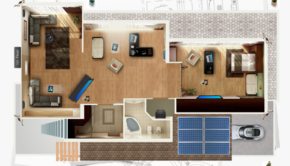The Role of Medical Sensors in Building Future Smart Homes
With time, bigger and bigger chunks of our lives are getting more convenient through smart devices. An average smart house is projected to feature over 500 smart devices by 2022. Those devices could be anything from smart bulbs to smart fans. We’ve even seen ‘smart bins’ come up recently, which have barcode scanners to scan the packaging you discard to automatically add those items to your shopping list. That’s absurd — absurdly, brilliant.
The same pattern will continue for integrated smart healthcare tech in future smart homes. These products—particularly automatic health monitoring devices and medical sensor technology— could introduce many opportunities.

Image source: https://unsplash.com/photos/_aN6zIDRLfQ
What Is a Smart Home?
The healthcare tech element within a smart home involves convenient alternatives to minor medical checks. For instance, imagine if your bed had sensors that track your sleep, or a toilet that tracks your bowel movement timings to notify you about irregularities, or a bathroom mirror equipped with a laser that detects your body temperature every morning. This data can help provide alerts if your health is compromised, making sure you get treatment as early as possible.
In the not-so-distant future, we will possibly be able to live in homes that have healthcare technology built into it. Smart homes will further transform into smart cities, ensuring effective and intelligent sharing of resources and making sure individual people get personalized healthcare services as and when needed.
According to Oxford University’s Sarah J Darby and Aalborg University’s Kristen Gram-Hanssen, there is no smart home definition written in stone as of now. However, the basic perspective of the concept involves advanced digital sensing technology that pairs with smooth communication to drive all-new possibilities for healthcare, convenience, and better living.
Role of Medical Sensors in Smart Homes
A 2017 study conducted by researchers of Scripps Translational Scient Institue (La Jolla, California) demonstrated that the telemonitoring of health data like body temperature, blood oxygen, respiratory biometrics, and blood pressure can largely decrease the rate of re-admissions of people fighting COPD (chronic obstructive pulmonary disease).
Currently, all of the above health data can be derived by using individual medical sensory devices like a pulse oximeter for blood oxygen levels, a blood pressure cuff, or different types of thermometers. Even today, most of these devices are must-haves to make sure your home is as medically smart as possible with current technology. If you do not have these in your home yet, feel free to take a look at these sensors. In the future, more of this sensory tech will hopefully be integrated into the everyday things we use around the house.
Conclusion
Smart homes will probably not be able to fully substitute personalized healthcare, but experts believe that most health conditions could be remotely and conveniently monitored in a smart home that has the necessary sensory tech installed.
While today’s health gadgets like fitness trackers and smartwatches aren’t quite up there yet, new solutions are constantly being innovated. The progress will ideally be based on interoperability between devices, allowing them to seamlessly communicate with each other.
















